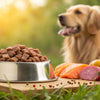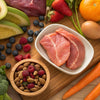Can My Dog Eat Raw Food? Understanding the Benefits and Risks of a Raw Dog Food Diet
- Houndsy
Table of Contents
- Introduction
- Understanding Raw Food Diets for Dogs
- Transitioning to a Raw Food Diet
- Alternative Nutritional Solutions
- Conclusion
Introduction
Have you ever wondered if your furry friend could thrive on a diet that more closely mirrors what their wild ancestors consumed? The growing trend of raw dog food diets has captivated many pet owners, tempting them with the promise of healthier pets and shinier coats. But before we dive into the specifics of whether or not dogs should eat raw food, let’s take a moment to reflect on the choices we make in our pet care routines. After all, we want our beloved companions to lead happy and healthy lives!
In this article, we'll explore the ins and outs of raw food diets for dogs—what they typically include, the potential benefits, the risks involved, and what veterinarians have to say. By the end of this post, you’ll not only be armed with valuable insights but will also be empowered to make informed decisions regarding your own dog's nutrition.
Our goal is to provide a balanced view that captures both the excitement surrounding the raw food movement and the precautionary tales that accompany it. We’ll also introduce you to a solution that may enhance your feeding routine: the Houndsy Kibble Dispenser. Let's dig in!
Understanding Raw Food Diets for Dogs
What Constitutes a Raw Food Diet?
Raw dog food diets, often referred to as "biologically appropriate raw food" (BARF) or raw meat-based diets (RMBD), typically include:
- Raw Meat: Muscle meat, organs (liver, kidneys), and bones.
- Fruits & Vegetables: Safe options like carrots, apples, and spinach.
- Raw Eggs & Dairy: Products like yogurt can add nutritional value.
- Occasional Grains: Some raw food diets may include small amounts of cooked grains, although they are less common.
The idea behind feeding dogs a raw food diet is that it aligns more closely with their evolutionary diet. Proponents argue that such meals can lead to healthier dogs—improved coats, stronger immune systems, and better overall health. However, it’s essential to examine both sides of the argument.
What Are the Benefits of Feeding Raw Food?
-
Natural Ingredients: Advocates assert that raw diets use only whole, unprocessed ingredients, which can be more palatable and nutritional compared to conventional dog foods.
-
Increased Energy Levels: Some dog owners report that their pets exhibit higher energy levels on a raw food diet, attributed to the natural protein found in raw meats.
-
Healthier Skin and Coat: Many claim that the high fat content and natural oils in raw meats contribute to shinier coats and healthier skin.
-
Dental Health: Chewing on raw, meaty bones may help reduce plaque buildup and promote healthier teeth.
-
Fewer Allergies: Some believe that feeding raw can alleviate dietary allergies or sensitivities in dogs, leading to fewer digestive issues.
Assessing the Risks of Raw Food Diets
While there are benefits, it’s crucial to recognize the significant risks associated with raw food diets:
-
Bacterial Contamination: Raw meat can harbor harmful bacteria such as Salmonella, Listeria, and E. coli, which can lead to severe gastrointestinal illness in both dogs and humans.
-
Nutritional Deficiencies: Without careful planning, a raw food diet may lack essential nutrients that dogs need for balanced health. Vitamin and mineral deficiencies can lead to long-term health issues.
-
Digestive Issues: Some dogs may have difficulty digesting raw foods, resulting in gastrointestinal upset like vomiting or diarrhea.
-
Choking Hazards: Raw bones can splinter, posing threats of choking or obstruction within the digestive tract, leading to emergency surgery in severe cases.
-
Contaminated Environment: Handling raw food increases the risk of cross-contamination in your kitchen and surrounding areas, putting family members at risk for foodborne illnesses.
Expert Opinions on Raw Diets for Dogs
Leading veterinary organizations, including the Centers for Disease Control and Prevention (CDC) and the American Veterinary Medical Association (AVMA), caution against raw diets. They highlight the significant risk of disease transmission as well as concerns over unbalanced nutrition.
Veterinarians often emphasize the importance of a well-rounded diet that adheres to specifications set by recognized organizations, ensuring your dog receives all necessary nutrients without undue health risks. If you're considering adopting a raw food diet for your dog, always consult with your veterinarian first.
Transitioning to a Raw Food Diet
Steps for a Safe Transition
If you've weighed the pros and cons and still wish to explore the world of raw diets, here’s how to do it safely:
-
Consult a Veterinarian: Discuss the plan thoroughly, ensuring that your dog’s unique health needs are considered.
-
Research Commercial Options: If opting for pre-packaged raw foods, choose products that adhere to nutritional adequacy statements from the Association of American Feed Control Officials (AAFCO) and are developed by veterinary nutritionists.
-
Start Slow: Gradually introduce raw ingredients into your dog’s diet. Start with small amounts and observe for adverse reactions.
-
Balanced Composition: Follow guidelines for a balanced diet, incorporating muscular meat, organ meats, fruits, and vegetables in a nutrient-rich manner.
-
Monitor Health: Keep an eye on your dog’s health during the transition. Look for any signs of digestive issues, skin irritations, or changes in energy levels.
Homemade vs. Commercial Raw Food
As we navigate the choices available, it's important to understand the distinction between homemade and commercially produced raw foods:
-
Homemade Diets: Often perceived as fresher, but they require careful formulation to ensure nutritional balance. Consulting a veterinary nutritionist is essential to avoid deficiencies.
-
Commercial Diets: Many are designed for convenience and safety but come at a premium. Opt for reputable brands that conduct extensive testing for pathogens.
Regardless of the route chosen, care must be taken to provide a diet that meets all the nutritional requirements for your dog’s breed, size, and health.
Alternative Nutritional Solutions
Cooked Diets
If raw food seems daunting or risky, don’t overlook well-prepared cooked diets. Cooked meals can be prepared at home or obtained from reputable manufacturers. They provide safety while ensuring nutrition can be tailored for your dog's specific needs.
High-Quality Kibble
Another alternative is investing in high-quality, nutrient-rich kibble. Brands that focus on wholesome ingredients can offer a balanced diet, mitigating many health risks associated with raw foods. Look for brands that prioritize natural ingredients, free from fillers and artificial additives.
The Houndsy Kibble Dispenser
At Houndsy, we emphasize elevating the everyday experience of pet care, including feeding routines. Our flagship product, the Houndsy Kibble Dispenser, combines innovative design with functionality, allowing for convenient feeding at a standing height—eliminating the need for bending. With its perfect portion control and stylish design, it's an ideal solution to simplify and beautify your pet feeding rituals.
Conclusion
When it comes to the question, "Can my dog eat raw food?" the answer is multifaceted. While there are potential benefits, the risks involved in feeding a raw diet cannot be overlooked. It is essential to weigh your options carefully, consult with your veterinarian, and consider safe, convenient alternatives that align with your dog’s health.
Feeding our dogs is more than just a daily task; it’s a sacred ritual that affects their overall well-being. Whether you choose to explore raw food diets or stick with cooked meals or premium kibble, our priority is to find a method that promotes health while enhancing the bond we share with our furry companions. Remember, when it comes to nutrition, informed choices pave the way for a happier and healthier dog.
FAQ Section
1. Can my dog eat raw food without health risks?
While some pet owners successfully feed their dogs raw diets, there are significant health risks associated with bacteria and nutritional deficiencies. Consult with a veterinarian before transitioning to a raw diet.
2. What should I do if my dog accidentally eats raw meat?
If your dog consumes raw meat unintentionally, you should monitor them for signs of illness, such as vomiting or diarrhea. If symptoms occur, reach out to your veterinarian.
3. Are there any specific breeds that should not eat raw food?
Certain medical conditions or sensitivities may indicate that a raw diet is inappropriate for specific breeds. Always check with your veterinarian for guidance tailored to your dog’s health.
4. What are some safe fruits and vegetables for dogs?
Safe options include carrots, apples (without seeds), blueberries, and sweet potatoes. Always wash fresh produce thoroughly before including it in your dog’s meals.
5. How can I ensure my dog’s diet remains balanced if I opt for raw food?
Work with a veterinarian or a veterinary nutritionist to design a meal plan that includes all necessary nutrients and vitamins, preventing deficiencies.
For those considering raw diets or seeking the best in dog nutrition, we encourage you to explore the Houndsy Kibble Dispenser and enjoy a well-balanced feeding experience!












